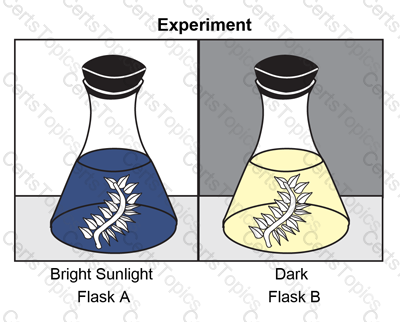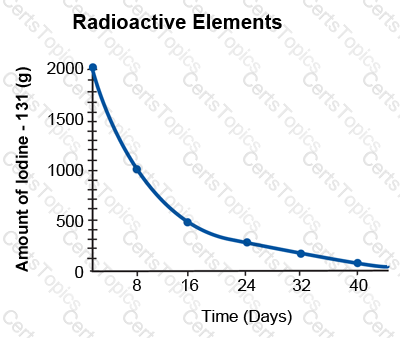-- Exhibit --
Since carbon dioxide dissolves in water to form an acid, an acid-base indicator such as bromthymol blue is used to track the acid concentration during plant photosynthesis and respiration. Bromthymol blue turns yellow in an acid solution and remains blue in a basic solution. The color change is reversible. A student used the following procedure to track carbon dioxide.
In an experiment, a student placed a solution of bromthymol blue into each of two flasks, inserted a drinking straw in each flask, and blew through the straw until the solution turned from blue to yellow. Carbon dioxide, a waste product in the student’s breath, caused the color change. The student then placed a small Elodea water plant in each flask and closed the flasks with rubber stoppers. Flask A was placed in bright sunlight, while flask B was placed in the dark for 24 hours, as shown in the figure below.

After 24 hours, the bromthymol blue in flask A had turned back to blue, while in flask B it was still yellow.
-- Exhibit --
What relationship was the experiment designed to explore?
The relationship between light and:
-- Exhibit --
The most realistic description of energy flow through an ecosystem is a food web that represents an interconnected series of food chains. In general, the greater the number of alternative channels through which energy can flow, the greater the stability of the food web and the ecosystem.

The diagram shows a typical food web for a wet meadow. The hawk and the fox obtain nourishment by preying upon rabbits, frogs, snakes, and mice. The fox may even eat grasshoppers. If, for example, the rabbit population is reduced, possibly because of bad weather during the breeding season, the fox and hawk would shift their predatory pressure to other forms of prey. The rabbit population would then have a chance to bounce back and the ecosystem would remain stable.
-- Exhibit --
Based on the diagram, which consumer would have the greatest chance of surviving if the amount of available prey changes during the different seasons?
Many years ago, beavers were introduced to a region of California that they had not previously inhabited. Forty years later, the beaver population had grown so much that a cluster of aspen trees used by the beavers for food and building materials inside the national forest became endangered. The beavers were also interfering with the water systems.
In retrospect, how would biologists most likely evaluate the impact of the introduction of the beaver?
Every radioactive element has a specific half-life, which is the amount of time it takes one-half of a sample to decay. The following graph shows the radioactive decay of 2000 grams (g) of Iodine-131. Iodine-131 has a half-life of about 8 days. So after 8 days, one half of the original sample, or 1000 g, of Iodine-131 remains.

Using the graph on the left, how much of the original 2000 g of Iodine-131 will remain after it has undergone radioactive decay for 16 days?